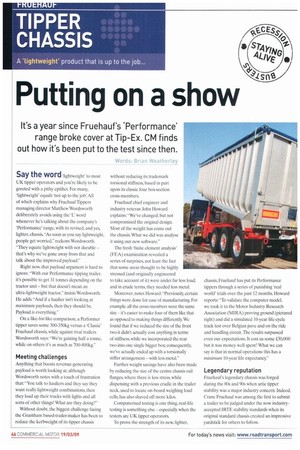Putting on a show
Page 46

Page 47

If you've noticed an error in this article please click here to report it so we can fix it.
It's a year since Fruehauf's 'Performance' range broke cover at Tip-Ex. CM finds out how it's been put to the test since then.
Words: Brian Weathertey Say the word lightweight' to most UK tipper operators and you're likely to be greeted with a pithy epithet. For many, 'lightweight' equals 'not up to the job: All of which explains why Fruehauf Tippers managing director Matthew Wordsworth deliberately avoids using the 'U word whenever he's talking about the company's 'Performance' range, with its revised, and yes, lighter, chassis. "As soon as you say lightweight, people get worried," reckons Wordsworth. "They equate lightweight with not durable — that's why we've gone away from that and talk about the improved payload."
Right now, that payload argument is hard to ignore. "With our Performance tipping trailer, it's possible to get 31 tonnes depending on the tractor unit — but that doesn't mean an ultra-lightweight tractor," insists Wordsworth. He adds: "And if a haulier isn't looking at maximum payloads, then they should be. Payload is everything."
On a like-for-like comparison, a Performer tipper saves some 300-350kg versus a 'Classic' Fruehauf chassis, while against rival trailers Wordsworth says: "We're gaining half a tonne, while on others it's as much as 700-800kg."
Meeting challenges
Anything that boosts revenue-generating payload is worth looking at, although Wordsworth notes with a touch of frustration that: "You talk to hauliers and they say they want really lightweight combinations, then they load up their trucks with lights and all sorts of other things! What are they doing?"
Without doubt, the biggest challenge facing the Grantham based-trailer-maker has been to reduce the kerbweight of its tipper chassis without reducing its trademark torsional stiffness, based in part upon its classic four box-section cross-members.
Fruehauf chief engineer and industry veteran John Howard explains: "We've changed, but not compromised the original design. Most of the weight has come out the chassis. What we did was analyse it using our new software."
The fresh 'finite element analysis' (FEA) examination revealed a series of surprises, not least the fact that some areas thought to be highly stressed (and originally engineered to take account of it) were under far less load: and in crude terms, they needed less metal.
Moreover, notes Howard: "Previously, certain things were done for ease of manufacturing. For example, all the cross-members were the same size — it's easier to make four of them like that as opposed to making things differently We found that if we reduced the size of the front two it didn't actually cost anything in terms of stiffness, while we incorporated the rear two into one single bigger box; consequently, we've actually ended up with a torsionally stiffer arrangement — with less metal."
Further weight savings have also been made by reducing the size of the centre chassis rail flanges, where there is less stress, while dispensing with a previous cradle in the trailer neck. used to locate on-board weighing load cells, has also shaved off more kilos.
Computerised testing is one thing, real-life testing is something else — especially when the testers are UK tipper operators.
To prove the strength of its new, lighter,
chassis. Fruehauf has put its Performance tippers through a series of punishing 'real world' trials over the past 12 months. Howard reports: "To validate the computer model, we took it to the Motor Industry Research Association (MIRA) proving ground (pictured right) and did a simulated 10-year life-cycle track test over Belgian pave and on the ride and handling circuit.The results surpassed even our expectations. It cost us some £30,000 but it was money well spent! What we can say is that in normal operations this has a minimum 10-year life expectancy!'
Legendary reputation
Fruehauf s legendary chassis was forged during the 80s and 90s when artic tipper stability was a major industry concern. Indeed, Crane Fruehauf was among the first to submit a trailer to be judged under the now industryaccepted IRTE stability standards when its original standard chassis created an impressive yardstick for others to follow. So what better way to prove the new design than to return to the tilt table at Chobham (above) where, says Howard, a fully laden Performance tipper recently achieved the IRTE 'Class A' requirement of remaining stable while being subjected to a seven-degree sideways tilt with the body fully raised —with the minimum of fuss. "We did it with both the Bathtub and the half-pipe," he adds.
Meanwhile, despite enjoying some 80% of the 13K tipping trailer market,Wordsworth asserts: "We're not arrogant enough to believe we know every bit of the business— but we're not losing prospects in the current situation. There are cheaper trailers on the market, but they have a lot more weight on them."
With the recent demise of United Trailers, and the fact that Fruehauf recently acquired all of its design rights, is Wordsworth tempted to enter new market sectors? He admits: "We've got plenty on our plates right now."
But there are plans to develop the firm's product portfolio, not least through a moving floor design with a semi-integral chassis, while a waste ejector trailer is yet another possibilit) For the moment, the traditional four box-section cross-member 'Classic' chassis will remain in production alongside the Performance range, which carries a £3,000 premium. "We're still building the 'old' version," confirms Wordsworth. "The take-up of Performance will be driven by the market." Given the need to maximise vehicle utilisatior in the current climate that take-up could be given an increasing impetus. •
















































































































































